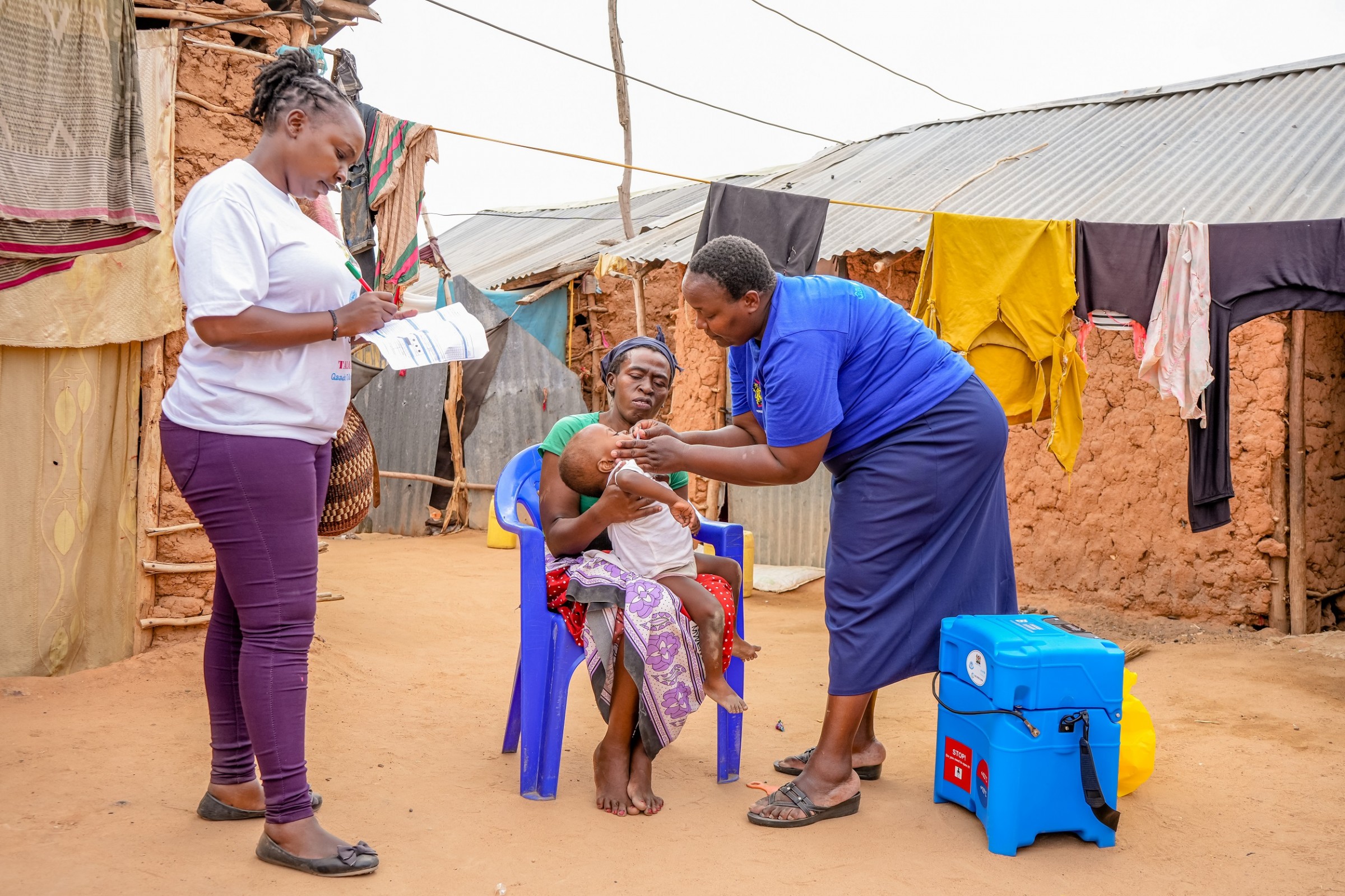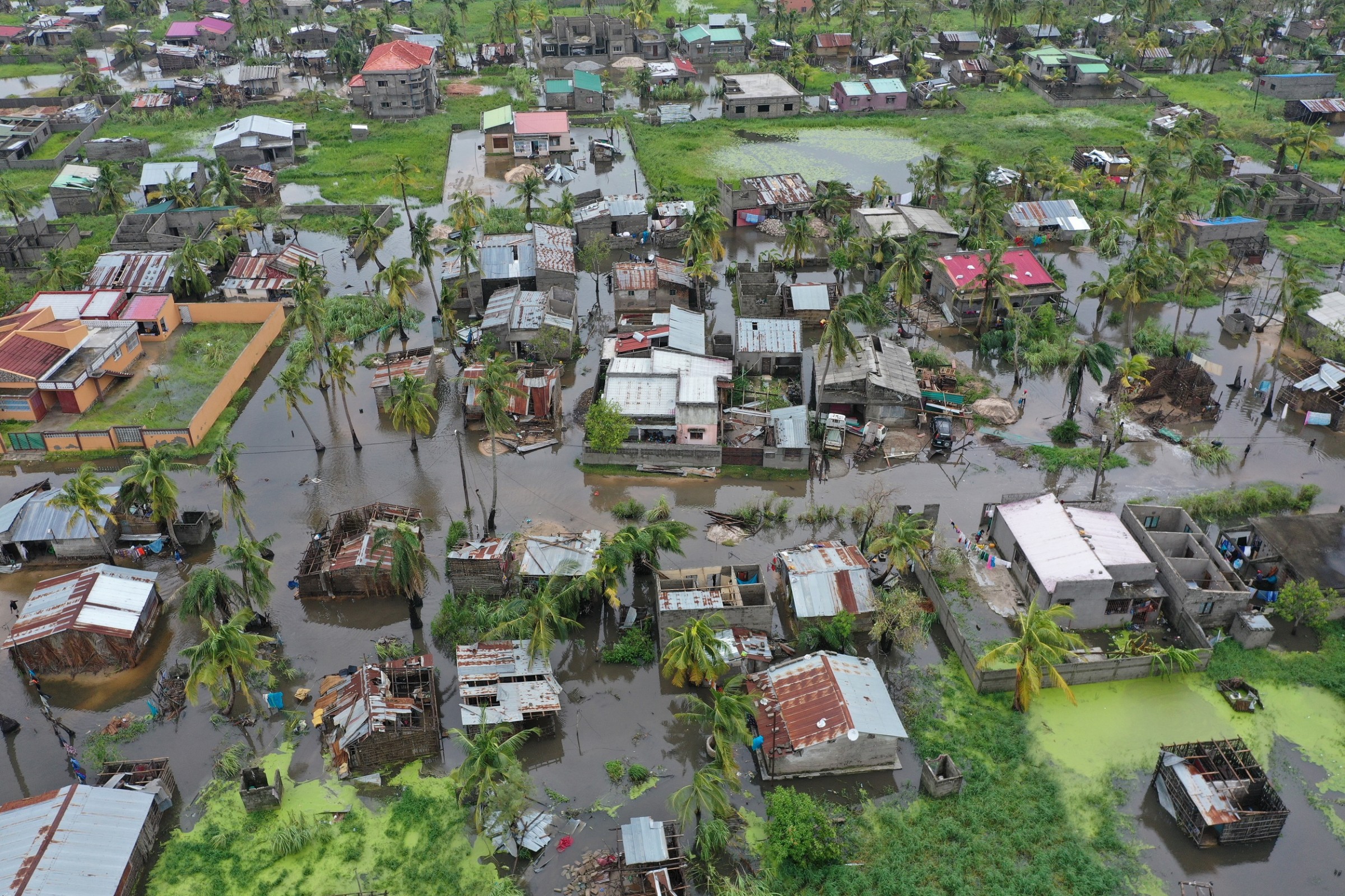Without clean water and sanitation, disease outbreaks multiply.

On February 16, 2023, head nurse Millicent gives oral cholera vaccine to a child at Madogo Health Centre in Tana River County, Kenya. The Ministry of Health of Kenya, working with WHO, UNICEF and other partners, vaccinated approximately 2 million people against cholera in a campaign that ran February 11-21, 2023. Photo © WHO/Billy Miaron
By Brett Walton, Circle of Blue – April 27, 2023
Cyclone Freddy, one of the longest-lasting tropical cyclones ever recorded, carved a treacherous path in Mozambique last month that underscored the vulnerability of the world’s poorest to climate disruption, displacement, and disease — and not just once but twice.
The long-lived storm came ashore in Zambezia province on March 11, the second time in two weeks that Freddy made landfall in the southern African country. High waters flooded homes, wrecked villages, cut power, destroyed healthcare facilities, and made rural roads impassable.
The displaced and newly homeless gathered in crowded shelters often with unsanitary conditions, said Christine Beasley, Mozambique country director for CARE International, a nonprofit aid agency. Latrines that were not designed for hundreds of people soon overflowed.
“And then the water sources get contaminated,” Beasley said. “And they’re just drinking and using contaminated water.”
It is a recipe for disease outbreaks, and that is what occurred. A surge in cholera cases hit Mozambique, centered on the provinces where Freddy made landfall. As of April 19, there were 27,353 suspected cholera cases reported in the country.
To the north, in the Democratic Republic of Congo, aid agencies are also hustling to quell a rising number of cholera cases in North Kivu province. More than one million people have fled from violence associated with the M23 rebels in the last year, according to the aid group Médecins Sans Frontières, also known as Doctors Without Borders. Dirty water and poor toilet facilities in displaced persons camps contribute to the cholera threat.
Weather extremes and conflicts like these in Mozambique and the Democratic Republic of Congo are uprooting people and fueling the spread of a treatable but enervating disease. Cholera, which is marked by severe diarrhea and dehydration, is spread through food and water contaminated with Vibrio cholerae bacteria. Contaminated food and water are the direct cause, but social and environmental events such as a massive flood or violent insurgency are putting more people in harm’s way. Today those catalyzing factors are converging to produce a series of cholera outbreaks that the World Health Organization (WHO) describes as a “very high” global risk.
“The size of the outbreak is very clearly linked with climate-related events, and that is in a context where we still have war and poverty and humanitarian crises that remain the other drivers of the outbreak,” said Philippe Barboza, WHO lead on cholera.
Through the end of March, according to WHO, cholera outbreaks were being reported in two dozen countries, largely in eastern and southern Africa. Ethiopia is having one of its longest outbreaks on record due to conflict in the Oromia region. Yemen is still reporting cases, despite having an outbreak starting in 2017 that infected more than one million people and was the worst in modern times. Cases are also high in northwest Syria, which is plagued by broken water and sanitation systems from years of fighting and, more recently, the magnitude 7.8 earthquake that struck the region on February 6.
These outbreaks are happening at a time of year when cholera cases are typically low, Barboza says. More cases could occur in the summer months, when the disease spreads more easily in warmer, wetter conditions. At least one billion people live in regions affected by the outbreaks and are at risk of contracting the disease, Barboza says.
So many cases have been reported that global vaccine stockpiles are low and the two-dose vaccine is being rationed at just one dose, which will reduce its effectiveness in children.
When Gina Charnley, a postdoctoral fellow at Johns Hopkins University who studies infectious disease, looks at the map of cholera outbreaks, she sees an obvious connection.
“Cholera is a disease of inequity and a disease of poverty,” Charnley said. “When you map cholera and poverty together, they sort of overlap. And so I think fundamentally, that’s what is driving cholera outbreaks: the fact that unfortunately, today, we still remain a very unequal world.”

A drone shot from the city of Quelimane shows the enormous impact and devastation caused by Cyclone Freddy on homes, schools, and other infrastructure in Mozambique. Flooding is widespread within the city and surrounding areas. Cyclone Freddy battered central Mozambique on Sunday, March 12, potentially breaking records for the duration and strength of tropical storms in the southern hemisphere. Photo © UNICEF /Alfredo Zuniga
Those inequalities are evident in everything from access to clean drinking water to having the financial resources to prepare for and recover from natural hazards like floods and heat waves that are strengthening because of more greenhouse gases in the atmosphere. Billions of people do not have safe drinking water and perhaps billions more do not have sanitation systems that safely dispose of toilet waste.
In light of these factors, disease outbreaks from extreme weather and a warming climate are not limited to cholera.
Malaria cases in Pakistan, for instance, quadrupled in 2022 compared with the previous year. Catastrophic monsoon floods submerged a third of the country last August, providing the conditions — standing water in which mosquitoes can breed; communities cut off from health services; increased poverty — that fueled malaria’s spread. The more than 160,000 cases represented Pakistan’s worst outbreak of the disease in a half century.
Diseases do not respect political borders. Lebanon saw its first cholera outbreak in nearly two decades last year due to spillover from neighboring Syria, where more than 100,000 suspected cases have been recorded since August.
Official case numbers should be viewed with caution, researchers say. Cases, especially if they are mild or in countries in conflict, are not meticulously counted. These outbreaks have been accompanied with an unusually high case fatality rate, a measure of how many people die from the disease.
Normally under one percent, the rise in the case fatality rate to nearly two percent globally and three percent in Africa could be a result of undercounting total cases. Barboza also attributed the rise to medical systems in poor countries that are stretched thin from responding to the Covid pandemic and other diseases.
Researchers refer to cholera as an ancient disease. Vibrio cholerae, the bacterium that spreads the disease, arose around the Ganges delta centuries ago. Illness is characterized by severe diarrhea and dehydration. Treatment is a matter of getting adequate, uncontaminated liquids. Clinics use an oral rehydration solution — sort of like Gatorade but with much less sugar.
In countries where cholera is endemic, the disease is part of life. Countries with little history of exposure are vulnerable. The incubation period for cholera is measured in hours. The disease can multiply rapidly under the right conditions.
On the Frontlines
When it came ashore a second time in Mozambique, Cyclone Freddy had already lived a full life. The storm had traversed the Indian Ocean and hit Madagascar before churning off the southern African coast as it regained strength.
After its second landfall in Mozambique the storm had been alive for more than a month. World Meteorological Organization researchers are now verifying the longevity records that Freddy might have broken.
The dual landfalls threw organizations like CARE International for a loop.
After disasters, CARE prioritizes water and sanitation — tasks like distributing chlorine water purification tablets and soap and rehabilitating wells contaminated by flood waters.
“They’re going to use that water because there isn’t any other water to use,” Beasley said.
The steps for containing an outbreak are well known: provide safe water, monitor illnesses for hot spots, wash hands, have access to rehydration, and use vaccines. These steps become much harder without the resources to achieve them. Both Barboza and Beasley bemoaned the general neglect of cholera from international donors. A $25 million emergency appeal from WHO in January was largely ignored, Barboza said, “because we have too many crises ongoing.”
In Mozambique, CARE’s field staff confronted daunting logistics. They had to reposition supplies to the second disaster zone once Freddy returned, but bridges were washed out and dirt roads soon became a muddy slog. “It can take four or five hours to go twenty kilometers [twelve miles],” Beasley said. Slow passage makes a convoy an easy target. Beasley said that bandits with machetes attacked one truck, stealing supplies. “It’s a ten-ton truck moving very, very slow.”
Despite the challenges, more cholera outbreaks on a warming planet can be avoided, Charnley said. Wealthier places almost never experience cholera outbreaks because they have functioning water and sewer systems. Countries could prevent the spread of the disease by investing in clean drinking water, toilet systems that safely manage waste, and widespread handwashing. Few health interventions have such a high return on investment. Dollars spent on water and sanitation mean less human misery.
“Until we address these underlying problems that we have,” Charnely said, “with people not being able to access safe drinking water, unfortunately, I do think it’s going to continue to be a problem.”
Brett writes about agriculture, energy, infrastructure, and the politics and economics of water in the United States. He also writes the Federal Water Tap, Circle of Blue’s weekly digest of U.S. government water news. He is the winner of two Society of Environmental Journalists reporting awards, one of the top honors in American environmental journalism: first place for explanatory reporting for a series on septic system pollution in the United States(2016) and third place for beat reporting in a small market (2014). He received the Sierra Club’s Distinguished Service Award in 2018. Brett lives in Seattle, where he hikes the mountains and bakes pies. Contact Brett Walton





